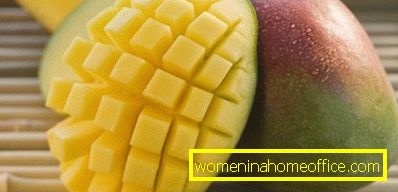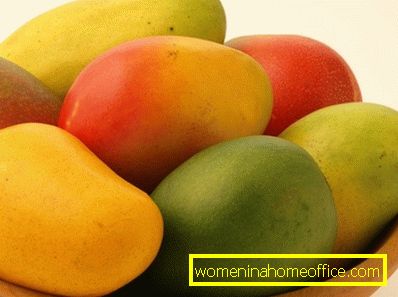How to eat mango
Mango is a fruit that is well tolerated even by small children and people with sensitive stomachs, but on condition that the fruit is ripe. In addition, it is an excellent source of vitamins. Only half of the mango will provide a daily dose of vitamin A. Today you will learn how to eat mango, but first you need to choose and peel it.
What kind of fruit is it and how is it eaten?

Agree, sometimes globalization is not so bad. For example, just recently, ten years ago, in order to eat fresh mango, you had to go on a long journey. Now, with such exotic dazzling shelves of our supermarkets all year round. Is this not a reason for joy, especially for people who are used to taking care of their health? After all, mango has all the characteristics of fresh vegetables recommended for our diet.
How to clean mango peel?
Since the mango fruit is such a benefit, let's quickly find out how to eat it. Usually, to get to the juicy and fragrant flesh of the fruit, it is peeled and cut. This can be done in several ways.
Method number 1:
- Pre-fruit must be well washed and dried. This condition is mandatory for all ways of cutting mango.
- After water procedures, you can peel it like an ordinary potato with a potato peeler or a sharp knife. At the same time try to cut off the peel as thin as possible, so as not to throw away the precious pulp with it, yet the mango is not a potato, even considering the cost.
- After cleaning, it is necessary to make transverse incisions of the pulp 1-2 cm wide to the very core of the fruit on both sides. I must say that the bone in the mango is flat, up to 1 cm thick and very hard. It is located in the heart of the fruit over the entire area of the longitudinal slice.
- After the pulp is completely divided by you into transverse segments, carefully cut it with a sharp knife along the entire bone area. Try to cut as close to the core as possible so as not to lose the flesh.
Method number 2:
- This method of cleaning is no less exotic than the fruit itself. Cut the unpeeled mangoes along the stone. You should have three parts: two cheeks with pulp and a core with a bone.
- Next, take a glass of thin glass, cut off the half of the mango at its edge so that the fruit is between the pulp and peel.
- Slightly pressing down a piece of mango, free it from the peel. Your cleaned pulp should remain in the glass, and the rind should remain outside.
Method number 3:

- And this is the most elegant way of cutting. Just as in the previous version, you separate the “cheeks” with pulp from the whole fruit.
- Then with the tip of the knife, make longitudinal and transverse cuts on the pulp over the entire area of the cut. You should get a notch in the form of cells.
- Patch the flesh to the skin, but not cutting through the shell of the fruit.
- After the notch is ready, turn it out with pulp like a hat. It should be a "hedgehog" of mango cubes, which can be eaten, separating from the peel with a spoon or fork.
You can eat mangoes unpeeled, imagining yourself on a desert island. However, there are several but:
- First, in spite of the fact that the peel contains not less vitamins, than pulp, in it there are quite strong allergens, and you risk your health.
- Secondly, it is quite dense and with a specific taste, so that you risk to spoil the entire impression of such an exotic dessert.
- Thirdly, eating a mango with peel is possible only if it is a fresh fruit. For transportation over long distances, its surface is treated with a special solution containing paraffin, so that the fruit retains its original appearance as long as possible.
Enjoy your meal!
Mango is tasty not only in its pure form. By the way, its taste is pulpy-reminiscent of a peach. From these fruits make a variety of dishes and drinks, thereby providing tropical pleasure. Obviously, with a sweet and juicy mango, excellent light, exotic desserts such as ice cream, fruit salad, creams, sherbet, thin rolls, cake or pie can be made. A special plus is refreshing and vitamin-rich drinks with the addition of mango juice.
But not only desserts can be cooked with this fruit. It can be salty foods. Fish, meat, poultry - the slightly sour mango flesh fits perfectly into exotic delicacies.
What is the use?
Mango is not only tasty, but also useful because of the extremely rich content of provitamin A and C. Only about 200 g of mango covers the daily human need for vitamin A and thus helps our body in regenerating skin cells, mucous membranes and articular tissues.
Provitamin A also strengthens the immune system and improves vision. In addition, the same 200 grams of mango contain approximately 74 mg of vitamin C, which is about three-quarters of the necessary daily human needs. The need for these vitamins is significantly increased in smokers, pregnant women and adolescents with growth spikes.

Mango has antioxidant properties, is rich in carotenoids and plant fibers, fiber. In this fruit can be compared with melon, carrots or green vegetables. To this you can add the low calorie content and the content of minerals and trace elements that are also involved in the balance of nutrition.
Nutritional value of 100 g mango:
- calories - 60 Kcal;
- protein - 0.5 g;
- fat 0.5 g;
- carbohydrates - 2.8 g;
- fiber - 1.7 g
How to recognize fresh mango?
If the fruit can not be plucked from the branch, then you need to know how to choose the mango on the store counter. The fruit will be of good quality when it is not too hard and soft. In any case, light finger presses on the surface of a fairly ripe mango should not leave marks of dents.
High-quality fruits also smell nice and sweet. The color of the rind of mangone is an indicator of taste and degree of maturity, however, it is worth buying fruit covered with black spots, since it is a sign of excessive ripeness.
Now you can safely go to the store for exotic and replenish your diet with vitamins. Eat tasty and right!